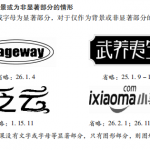Determining whether trademarks are similar in China is a relatively complex process that requires comprehensive consideration of multiple factors.
1.Comparison of the constituent elements of trademarks
1.1Word trademarks
Similarity in glyphs: mainly observe the shape and structure of the words. For example, “康帅夫” and “康师傅”, “帅” and “师” are similar in glyphs, and this similarity may cause confusion among consumers.
Similarity in pronunciation: focus on the pronunciation of the words. For example, “六个核桃” and “大个核桃”, “个” and “六” have different pronunciations, but the pronunciation rhythm of the overall trademark is similar, which can easily cause consumers to misunderstand when they hear the trademark name.
Similarity in meaning: if the meanings of the trademark words are similar, they may also constitute similar trademarks. For example, “光明” and “光亮” have very similar meanings, and when used on the same or similar goods, it is easy for consumers to be difficult to distinguish.
1.2Graphic trademarks
Overall appearance of the graphics: check the overall shape and outline of the graphics. For example, both trademarks have circular outlines, and although the details of the internal patterns are different, the overall visual experience is similar, so they may be identified as similar trademarks.
Graphic body: for complex graphics, focus on comparing the main body. If the main parts are similar, even if other details are different, they may constitute similarity. For example, two trademarks are both based on animals, one is a realistic tiger, and the other is a cartoon tiger. They may be considered similar in terms of overall visual effect.
Graphic design style and element combination: Similar design styles (such as both are retro style or modern minimalist style) and element combination methods (such as both use geometric graphic combinations or animal and plant and text combinations) will also affect the judgment of trademark similarity.
1.3Combination trademarks (text and graphic combination)
Combine overall comparison and main part comparison: First, make an overall observation to see whether the overall impression of the trademark is similar. Then focus on comparing the main parts. Generally speaking, the text part is usually the main part, but if the graphic part has a high degree of distinctiveness, it will also be considered. For example, one trademark is the word “happy” plus a simple smiley face graphic, and the other trademark is the word “happy” plus a similar smiley face graphic. When judging, we should consider the overall feeling of the text and graphic combination, and also focus on comparing the similarity of the text part.
2.Category association of goods or services
2.1Judgment of similar goods or services
The reference role of the “Similar Goods and Services Distinction Table”: The Trademark Office will refer to the “Similar Goods and Services Distinction Table” when determining the similarity of trademarks. This table divides goods and services into different categories, and goods or services in the same category are generally considered to have a high degree of association. For example, in the 25th category of clothing, men’s clothing and women’s clothing are considered similar goods; in the 43rd category of catering services, restaurant services and cafe services are similar services.
Consideration of actual market conditions: In addition to referring to the distinction table, the actual market conditions will also be considered. Although some goods do not belong to the same category in the distinction table, they may be related in actual market transactions and consumer cognition. For example, cars and car tires belong to different categories in the distinction table, but in the eyes of consumers, they are closely related goods. In this case, if the trademarks are similar, it is also easy to cause confusion.
3.Consumer cognition and possibility of confusion
3.1The degree of attention of ordinary consumers
Differences in the degree of attention of different goods or services: Consumers have different degrees of attention when purchasing different goods or services. For high-value, low-frequency goods (such as real estate and cars), consumers are usually more cautious and pay more attention to trademarks; while for some low-value, high-frequency daily necessities (such as paper towels and snacks), consumers pay relatively less attention. When judging whether trademarks are similar, it is necessary to consider this difference in attention when consumers purchase specific goods or services. For example, for the trademarks of high-end cosmetics brands, even if there are some subtle similarities, consumers may carefully distinguish; but for ordinary stationery brand trademarks, consumers may be more likely to ignore some small differences and cause confusion.
3.2Types and degrees of confusion
Source confusion: The most common is that consumers mistake one trademark for another, thereby confusing the source of goods or services. For example, consumers see a trademark similar to a well-known brand trademark and think it is a new product or new series launched by the well-known brand.
Association confusion: Although consumers will not mistakenly believe that two trademarks are from the same source, they will believe that there is some kind of association between them, such as licensed use, affiliation, etc. For example, if a small brand trademark is similar to a large brand trademark, consumers may think that the small brand is authorized by the large brand.
When determining whether trademarks are similar, the trademark examination agency or the court will use the above methods in combination, starting from the perspective of ordinary consumers, considering factors such as the constituent elements of the trademarks, the category of goods or services, and the possibility of confusion, and make an objective and fair judgment.
